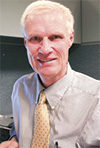I have come home. From the East Coast to the Pacific Northwest, from Washington D.C. to Washington State, and from the nation’s capital to the evergreen states of the Pacific, my journey is a pilgrimage home.
As most readers of this column know, I own and fly a Mooney aircraft as a general aviation pilot. I departed Manassas Regional Airport in northern Virginia about mid-June, with a stop at home in Alma, Michigan.
Flying north and then west through the Upper Peninsula of Michigan, over Wisconsin, I arrived at Willmar, Minnesota. At the airfield is a Mooney service center. We replaced a gasket that sealed the fuel pump to the engine casing, stopping a slow leak of oil that had resulted in an oil streak down the belly of the airplane after a several-hour flight.
Once fixed, I flew the next leg to Billings, Montana. I saw many flooded fields, especially in western Minnesota and the entire east-to-west orientation of South Dakota. The next day I flew over the Rockies at 12,500 ft., with my oxygen mask on, making note of the scenery as my autopilot flew the plane through the rest of Montana, over the Idaho panhandle, finally to land at Pendleton, Oregon, for fuel. And then back in the air for my final leg into Aurora, Oregon, just south of Portland.
I had driven the Interstate 84 route many times, but never saw this part of Oregon through the windshield of an airplane at 6,500 ft. Flying through the Columbia River Gorge was special, and then I saw my home of Hood River and our landmark, Mt. Hood. As I flew by, I tried to find our farm in Parkdale, but could not.
The gorge is a funnel of airplanes coming into Portland, and air traffic control gave me specific instructions with vectors westbound for avoiding other airplanes, including commercial airliners, and importantly, terrain especially on the port side, or south side, of my flight path.
Once near Portland, I turned the autopilot off and a few minutes later, entered the traffic for a full stop landing at Aurora, Oregon, thus completing my coast-to-coast flight.
My oldest son, Tony, and his four children, greeted me on the ramp. I had not seen them since my earlier deployment in Afghanistan, so our reunion was wonderful.
Two days later I flew north following Interstate 5 to Arlington, Washington. The flight, at 6,500 ft., took me very near Seattle and Boeing Field and the beautiful blue waters of the Puget Sound. My brother Max met me at the airfield, and I spent a few days visiting him, my sister Madeline and my mother.
My next flight is inbound to Redmond, Oregon, to visit my ex-sister-in-law, Melba. From there I will make the very short flight over to Hood River. Our 40-year high school reunion (Hood River Valley class of 1971) is this July, and I will be attending this time.
I have not attended a high school reunion before, but the little voice inside of me says, “Go to this one.” A lot has happened in 40 years, and I suspect there will be many stories told … many good ones and some not-so-good too.
I will visit the farm in Parkdale. I have not been home for a number of years, with overseas deployments and busy schedules, but it’s time I return home and see the farm.
In the earlier years of writing this column, I made the case that the roots of our lives as farm children are found in a physical place. I still believe this. As I have traveled the world, the longing to once again be near the farm is with me. I have walked in crop fields in dozens of countries, but none are like the volcanic loam soils of Cascade Farm in Parkdale.
I am not sure what I will do there. The dairy herd has long been gone, and the housing buildings now store farming equipment. But I am reasonably sure I will know what to do when I arrive.
Often in this column, I have written about pilgrimages, the seekers embarking on an odyssey of self-discovery and enlightenment. So this journey is, for me, an odyssey not so much of self-discovery, but a release into the world outside of oneself.
By this, I mean a sense of abandonment of oneself, opening up to the world and seeing what we might find. This is the outer journey. We survey the physical landscape and know that we are a part of it. I submit rather than try to figure out how we might fit into the landscape, we accept that we already have.
Flying over the Rocky Mountains was in many ways a humbling experience. The pilgrimage of flight over a rugged and unforgiving terrain brings forth a sense of majesty and awe as well as my tiny metal airship hurling through the cold airspace at 180 miles per hour.
I did not sense dominion over the landscape, nor did I think that I had power over it. I merely accepted my place in this journey with a sense of awe, of beauty and, certainly, of humility.
Perhaps this is the outcome of a pilgrimage. A pilgrim enters the landscape as a seeker of knowledge, a seeker of purpose and a seeker of life’s meaning. But during the journey, the pilgrimage that begins as an inner journey gradually shifts to an outer journey.
And this may be why we truly find magnificence in our lives if we will just look. The vastness of the forests over West Virginia, the extensive farm lands of Ohio, Michigan, Wisconsin, Minnesota and South Dakota, the jagged terrain and topography of Montana and Idaho, the eastern Oregon wheat fields and then the narrow Gorge brought forth by the mighty Columbia River, all have entered into my own pilgrimage. I felt but just a speck in this journey.
The overwhelming magnificence of this cross-country journey, the pilgrimage of pilot in a single-engine airplane, brings forth the beauty of the world. Here, in the physical landscapes of soils and water and trees and crops and urban cities and rural farm lands, are the discoveries of abandoning oneself to the world.
We let go. And as we do, the realization of magnificence and beauty shape our insight into our own inner journey. Yes, like everyone else, I seek the answers to profound questions of meaning and understanding and of a life that has been lived well.
And my flight is one that has brought meaning to my life … simply looking out the windshield of my cockpit and realizing I am a part of this vast landscape. I do not need to think about this at a deeper level, for letting go of oneself, the emptying of a life into the world, and seeing what is there with acceptance, magnificence and beauty, is the outcome of a pilgrimage home that I have found. PD

-
Mike Gangwer
- Agricultural Scientist
- USDA-NRCS
- Email Mike Gangwer



